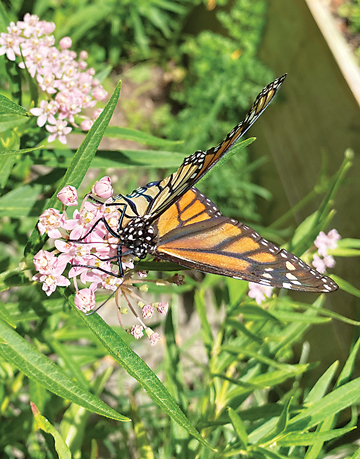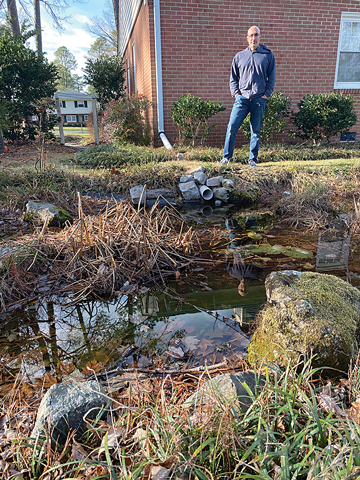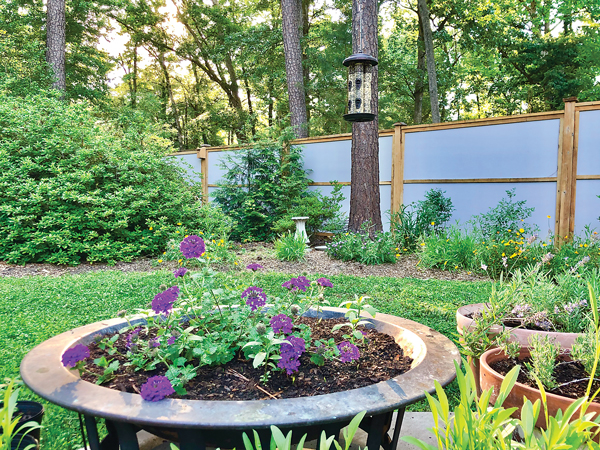When NBC12 meteorologist Andrew Freiden and his wife purchased their home in Henrico, they ripped out a large, semi-circular driveway in front of the house. While removing such a convenient aspect of the property might seem surprising, it’s actually one of the best things they could have done for their yard, the James River, and the Chesapeake Bay.
Like the Freidens, our family has been making changes to our property with the goal of being better friends to the environment. Our yard isn’t picture perfect, but we’re okay with that – knowing that we’re making a small but worthwhile difference is worth any shortcomings it might have. In addition to the benefits for the ecosystem, leaning green has enabled us to save time and money and explore plenty of teachable moments with our young children, who are already turning into conscientious stewards with a mind for conservation.
Many property owners are increasingly taking advantage of all the ways they can tweak their yards to benefit the environment around them. Adding the right plants or trees. Using a rain barrel. Scooping the poop. Large or small, making changes adds up, and the best part is that anyone can take part. Here’s why and how.
More isn’t better.
You know the dream. It’s what some people think of as the perfect yard: a smooth and uniform sea of crisp green grass, tidy and weed-free flower beds, and the tell-tale lawn maintenance sign stuck into the ground beside the flawlessly sealed driveway.
 As alluring as this idyllic landscape might sound, it’s actually a big threat to the environment. The more fertilizer, the more nitrogen and phosphorus runoff. The more pesticides and herbicides, the more pollution. The more impervious the surface (think asphalt), the more chemical-laden rainwater heads into the storm drains. Everything that leaves a yard trickles down to the James and ultimately ends up in the Chesapeake, threatening the many species (humans included!) that make their home within the ecosystem.
As alluring as this idyllic landscape might sound, it’s actually a big threat to the environment. The more fertilizer, the more nitrogen and phosphorus runoff. The more pesticides and herbicides, the more pollution. The more impervious the surface (think asphalt), the more chemical-laden rainwater heads into the storm drains. Everything that leaves a yard trickles down to the James and ultimately ends up in the Chesapeake, threatening the many species (humans included!) that make their home within the ecosystem.
According to the James River Association (JRA), which works to protect and improve the waterway through action and advocacy, precipitation is likely to increase by five to thirty-five percent by the middle of the century because of global warming. More rain equals more storm water runoff from properties, as well as overflow from outdated sewer systems. The JRA reports that in 2021 alone, there were 2,122 million gallons of combined sewer overflow. It all emptied into the James River.
Add to this the impact of having too many invasive plants. Sure, what you’ve planted (or inherited when you purchased your property) might have killer curb appeal, but it’s likely not doing the insects and animals that make their home in your neck of the woods any favors. According to the Virginia Department of Conservation and Recreation (DCR), invasive plants can lead to a chain reaction detrimental to the food web. Invasive plant species can become unwieldy and box out the growth of natives, hindering the development of insects and other species that rely on them. Without plants native to our part of the region, the insects and birds that naturally populate our area won’t be able to effectively carry out their pollination and food chain duties.
Fortunately, there are plenty of ways to make a yard appealing while remaining mindful of the environment.
Become a neighborhood hero.
“Grassy lawns are nice. Turf is nice. But it’s not great for the environment, for the waterways, or for the James River,” says Justin Doyle, community conservation manager and overseer of the River Hero Homes program for the James River Association. Plus, he adds, maintaining a pristine landscape takes a big investment of time and money.
Instead of going to all that effort to produce something that’s harmful to the waterway, making environment-friendly choices results in a win-win for property owners and the ecosystem.
River Hero Homes from JRA is intended for anyone who wants to have a hand in these important conservation efforts. From single family homeowners in rural areas, to suburb dwellers like my family, to downtown apartment renters, a River Hero Home can be achieved by practically anyone with the will to make positive change.
“To become a River Hero Home, folks choose at least three of five behaviors that they commit to,” Doyle explains. “Pick up after your dog, reduce or eliminate the use of herbicides or pesticides, avoid invasive species, use native plants to support wildlife and reduce watering needs, and reduce the need for fertilizer by increasing healthy soil with mulch and compost.”
About River Hero Homes, Doyle says it was a goal of the JRA to “create a program that’s easy to access and easy to understand.”
The program has been around for more than a decade, and while Doyle says there has always been great interest in it, he has seen an uptick in participation during the pandemic, since so many of us are spending more time at home and outside.
“People have made this new connection with their outdoor spaces and are thinking about how they can be more environment-friendly with their yards,” says Doyle.
Folks looking to make changes have a significant degree of flexibility. According to Doyle, homeowners can let their property turn into a yarden full of native plants, trees, and minimal to no landscaping; they can cultivate and landscape meticulously with conservation in mind; or they can fall somewhere in between, like my family’s yard.
With a little research, you can do it yourself or hire a landscape architect to draw up plans. Either way, Doyle says, it’s important to be mindful of what you don’t want.
What is a yarden?
You’ve probably heard the term yarden – it’s a marriage of yard and garden. No matter how you feel about the word itself, a yarden is one way to get creative with your outdoor space and support the ecosystem at the same time.
Perhaps the centerpiece of any good yarden is its inclusion of native plants and trees. Circling back to the ways in which natives are beneficial, the DCR says there are many: natives require less water and maintenance, attract more wildlife, and provide crucial habitats for many species.
From fruit trees and grasses to shrubs and perennials, there’s a massive selection to choose from. You can visit PlantVirginiaNatives.org or the Virginia Native Plant Society (vmps.org) to learn more about the right plants for our area. Or, you can ask an expert like Ann Jurczyk.
Jurczyk, Virginia’s director of outreach and advocacy for Chesapeake Bay Foundation (CBF), is a native landscaping expert and restoration project manager. She knows exactly what’s good to include and to exclude to turn a yard into a natural haven.
She also understands the trepidation many property owners might experience at the thought of making any changes to their yards, let alone sweeping ones. But conservation landscaping doesn’t have to look messy, she assures us.
“It doesn’t have to look necessarily more natural or untended… it can still be gorgeous,” Jurczyk says.
Reducing or removing invasive species is a good first step for everyone.
“They (invasive species) take up valuable real estate where you can put things that have a tremendous benefit to habitat,” says Jurczyk.
This includes rethinking the space that might have been reserved exclusively for turf. Likening lawns to a child’s slip and slide, Jurczyk says rain water glides off many grassy lawns, where it likely picks up fertilizer and chemicals before it goes into the storm drain. If there’s less lawn and more deeply rooted native plants, rain is absorbed better. The result is less junk ending up in the James and more naturally fed plants and habitat in the environment.
Jurczyk also urges homeowners to plant trees, such as oak, sycamore, river birch, or black gum.
“The reason we prioritize trees is that the benefits are just so massive,” she says, noting that trees mean caterpillars, and caterpillars mean birds.
“If you’re going to take up valuable real estate, plant something that’s going to provide value for birds.”
Similarly, the right native plants will attract bees and butterflies, essential for their roles in pollination and pest control.
For people who are interested in making changes but are on a budget, the Virginia Conservation Assistance Program is worth looking into, says Jurczyk.
Whatever outdoor edits property owners want to make, Jurczyk tries to design appealing and interesting landscapes with plenty of native species.
“I try to replicate nature the best I can and add as much biodiversity as I can in my landscape,” she says. And when it comes to something that doesn’t excite her in the landscape, Jurczyk takes a Marie Kondo approach and just won’t include it. Whether it’s inside or outside your house, she says, “life’s too short for stuff that we don’t love.”
Simple changes you can make!
In addition to removing that asphalt circular driveway, Andrew Freiden (shown left)and his family have adopted other effective conservation practices at their home. And my family has, too. Here are some relatively simple things to try:
Leave the leaves.
“An easy thing to do in the fall is to use those leaves in your beds,” Doyle says. “It’s so easy to blow or rake those leaves in your beds to keep weeds down, but also to add nutrients to the soil and feed your plants.”
Like Doyle, Freiden uses fallen leaves to his (and the environment’s) advantage.
“Leaves aren’t a waste product – they’re a whole lot of nutrients pulled up from soil in your yard,” he explains. Instead of bagging up leaves in the fall for the landfill, Freiden recommends leaving leaves and their nutrients on site for beds or turf, where they turn to mulch.
“Let it be life-giving for things that are growing,” he urges.
Here at the Boycourt ranch, (in reality, an HOA property in the Richmond suburbs), we mow over leaves in the fall so they can serve as food for our lawn and beds.
Don’t mow too short.
Another thing my husband and I have learned recently (and one that will be helpful as growing season approaches) is to adjust our mower so that our grass doesn’t receive such a dramatic clipping. If you cut your lawn too short, the grass won’t be able to absorb much water. The more water it can hold, the less runoff heads down storm drains. Plus, the folks at CBF, which has been working to “Save the Bay!” for more than fifty years, say the taller the grass, the less likely it is that weeds will sprout. The foundation recommends keeping turf grass between two and three inches high.
Cancel (or at least reduce) the chemicals.
It’s been years since Freiden last applied any herbicides or pesticides on his property.
“When you look at your yard, it’s not effective or smart to bring in a bunch of chemicals, when you have your kids and your dog playing in the grass,” he says.
To keep the Boycourt lawn looking respectable, we use a local yard maintenance company that prides itself on using healthier ingredients to maintain just our front yard. I was skeptical at first – that kid- and pet-safe treatments could keep weeds at bay and our lawn looking good – but we’ve been very pleased with the results.
Conserve and reuse water. 
Using a rain barrel, as the JRA will tell you, is an excellent way to repurpose the water that would normally run off your roof or other surfaces and ultimately end up in the James River. Instead, the captured water can be used for any number of worthwhile purposes including watering your garden or yard, cleaning patio furniture or cars, or refilling a pond.
“We’re very aware that what happens on our property has impacts beyond us, in particular when it comes to the James River and the Chesapeake Bay,” Freiden explains. “So we do our best to keep all of the storm water runoff – any drop of rain or snow that falls – on our yard as long as we can.”
At the Freiden residence, this has included directing a downspout so that it empties into a small frog pond they created in the backyard. Instead of precipitation running off the roof and making a quick exit to the Bay, water finds a useful and healthier purpose as a habitat and nifty and natural landscaping feature.
As for my family, we just took the pledge to be a River Hero Home and are looking forward to setting up our new rain barrel.
Finally, learn to let it go!
When we purchased our home, we inherited a backyard with tufts of short grass, a landscaped section with minimal plants and more rocks, and a modestly wooded area. In the past two years, we’ve committed to more or less letting it go, which has meant allowing the grass to grow longer, watching saplings stake their claim even if their location isn’t ideal, and most importantly, giving that landscaped portion the freedom to go its own way.
Now, bees and butterflies happily make use of the native plants growing on what was once a relatively barren berm. We hung a bird feeder there, too, and the entire family has enjoyed becoming bird watchers now that so many more grace the yard.
In this case, letting it go and creating an informal yarden has been a game changer for my family and our small piece of the environment. And in this writer’s unsolicited opinion, life’s too short not to leave our patch better than we found it. And now you know how!
Photography: Laura Boycourt, Justin Doyle, Drew Harrigan, courtesy Andrew Freiden), Daphne Cole





